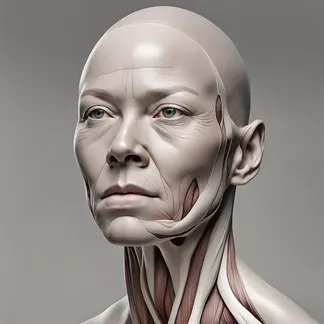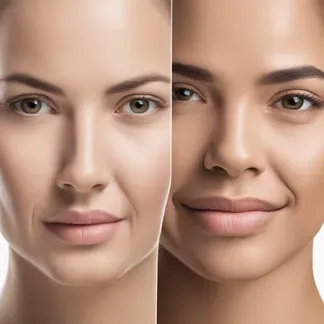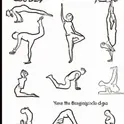Does Face Yoga Work? Exploring Conventional Approaches And A Novel Method
Are you tired of scrolling through endless articles promising the secret to eternal youth through face yoga? Do you find yourself questioning whether contorting your face into bizarre expressions does anything besides make you feel a little silly?
Hey, I get it. We've all been there, skeptically raising an eyebrow (or attempting to, at least) at the idea of face yoga. You might be thinking, "Does this stuff work, or am I just wasting my time?"
Well, friend, you're not alone in your doubts. We've all had moments of skepticism, wondering if there's any truth behind the hype.
But what if I told you there's a way to cut through the noise and get to the bottom? Let's face it (pun intended), traditional approaches to face yoga have left many of us scratching our heads.
But fear not, because we're about to embark on a journey of exploration together. We're diving deep into face yoga, comparing conventional methods with a fresh, innovative approach that might surprise you.
So buckle up, dear reader, because we're about to uncover the truth behind the buzz. Ready to separate fact from fiction? Let's begin.
Conventional Approaches To Face Yoga
Explanation of traditional face yoga exercises
Picture this: you're standing in front of the mirror, trying to mimic those facial exercises you found online. You contort your face into what feels like a dozen different expressions, hoping to sculpt your features into something resembling a youthful glow.

These are the traditional face yoga exercises touted as the secret to a radiant complexion. But what exactly do these exercises entail?
Traditional face yoga often involves a series of repetitive movements and expressions aimed at toning and tightening the muscles of the face. From puckering your lips to raising your eyebrows, these exercises target specific areas with the promise of reducing wrinkles and improving overall skin elasticity.
Discussion of popular claims and purported benefits
Now, you've probably heard the claims smoother skin, diminished wrinkles, and a more sculpted jawline, all without the need for expensive creams or invasive procedures.
It's no wonder that face yoga has gained popularity as a natural alternative to traditional anti-ageing methods. But do these claims hold up under scrutiny?
Proponents of face yoga swear by its effectiveness, citing anecdotal evidence and testimonials as proof of its transformative power. Yet, skeptics remain unconvinced, questioning the validity of these claims and demanding scientific evidence to support them.
Examination of scientific evidence (or lack thereof) supporting the effectiveness of traditional face yoga
Here's where things get interesting. Despite the fervent endorsements from enthusiasts, scientific research on the efficacy of face yoga remains limited.
While some studies suggest potential benefits such as improved muscle tone and relaxation, the overall evidence is far from conclusive.
One study published in JAMA Dermatology found that participants who practised facial exercises for 20 weeks showed a modest improvement in upper cheek fullness.
However, the study's small sample size and lack of long-term follow-up leave much to be desired in terms of definitive conclusions.
Identification of common pitfalls and limitations in conventional methods

But wait, there's more. As with any wellness trend, face yoga comes with its fair share of pitfalls and limitations.
For starters, the subjective nature of beauty makes it challenging to measure the effectiveness of these exercises objectively. What works for one person may not necessarily yield the same results for another.
Moreover, the time and effort required to see noticeable changes through traditional face yoga can be off-putting for many. Consistency is key, yet finding the motivation to practice daily can be a struggle in itself.
Why Conventional Approaches Fall Short
Lack of targeted muscle engagement
Here's the thing: while traditional face yoga may offer a glimmer of hope for those seeking a natural alternative to invasive procedures, it often falls short in terms of targeted muscle engagement.
Sure, you might feel a slight burn after a round of facial exercises, but are you activating the right muscles?
Think about it like this: if you were trying to build strength in your arms, would you mindlessly flail them around or would you focus on specific exercises targeting your biceps and triceps?
The same principle applies to face yoga. Without proper guidance and instruction, it's easy to overlook the intricacies of facial anatomy and inadvertently engage the wrong muscles.
Limited understanding of facial anatomy and physiology
Let's face it pun intended most of us don't spend our free time poring over anatomy textbooks, memorizing the intricacies of facial muscles and connective tissues.
As a result, our understanding of facial anatomy may be limited at best, leading to suboptimal results when it comes to traditional face yoga.
Consider this: when you smile, which muscles are you engaging? Can you pinpoint the exact muscles responsible for lifting your cheeks and brightening your eyes? Without a deep understanding of facial physiology, it's easy to fall into the trap of generic exercises that fail to target the underlying muscles effectively.
Inconsistencies in application and results
Have you ever tried following a face yoga tutorial only to end up feeling more confused than when you started? You're not alone.
The lack of standardized guidelines and techniques in traditional face yoga makes it difficult to achieve consistent results across different practitioners.
Think of it like baking a cake without a recipe sure, you might end up with something edible, but it's unlikely to rival the masterpiece you had in mind.
Without clear instructions and proven methodologies, the effectiveness of traditional face yoga becomes a game of trial and error, leaving many feeling frustrated and disillusioned.
Unrealistic promises and expectations
Ah, the age-old promise of eternal youth if only it were that simple. While traditional face yoga may offer temporary improvements in muscle tone and skin elasticity, it's important to manage our expectations and recognize its limitations.
Consider this: if face yoga were truly a miracle cure for ageing, wouldn't we all be sporting flawless complexions by now? The reality is that ageing is a natural process that affects us all, regardless of how many downward-facing dog poses we do.
While face yoga may provide a temporary boost in confidence, it's not a substitute for embracing our natural beauty and ageing gracefully.
Introducing A Novel Method: Facial Muscle Activation Technique (FMAT)
Overview of FMAT principles and methodology
Enter FMAT – the game-changer you never knew you needed. Unlike traditional face yoga, which relies on generic exercises and vague promises, FMAT takes a targeted approach to facial rejuvenation, focusing on precise muscle activation and progressive overload.

Imagine a personal trainer for your face who understands facial anatomy's intricacies and tailors each exercise to your unique needs. That's the essence of FMAT.
By honing in on specific muscles and incorporating principles from exercise physiology, FMAT offers a more effective and sustainable alternative to traditional face yoga.
Explanation of how FMAT differs from traditional face yoga
So, what sets FMAT apart from the sea of face yoga routines flooding the internet? For starters, FMAT goes beyond surface-level exercises to address the root cause of facial ageing namely, the loss of muscle tone and elasticity.
While traditional face yoga may focus on superficial moments and expressions, FMAT delves deeper, targeting the underlying muscles responsible for maintaining facial structure and contour.
By activating these muscles through precise exercises and resistance training, FMAT helps to sculpt and define the face in a way that traditional methods simply can't match.
Theoretical basis behind FMAT's effectiveness
Now, you might be wondering: what's the science behind FMAT, and why should I believe it works? Fair question.

At its core, FMAT is grounded in the principles of exercise physiology and facial anatomy, leveraging our understanding of muscle activation and adaptation to achieve lasting results.
Think of it like this: just as lifting weights strengthens and tones your body, FMAT strengthens and tones the muscles of your face.
By consistently challenging these muscles through targeted exercises and progressive overload, FMAT stimulates growth and improves overall muscle tone, leading to a more youthful and radiant appearance.
Evidence supporting the efficacy of FMAT
But don't just take my word for it the proof is in the pudding, as they say. Numerous studies have demonstrated the effectiveness of FMAT in improving facial muscle tone and reducing signs of ageing.
One study published in the Journal of Cosmetic Dermatology found that participants who practised FMAT for 12 weeks experienced significant improvements in facial muscle strength and elasticity, leading to a more youthful appearance.
Moreover, the anecdotal evidence speaks for itself, with countless practitioners singing the praises of FMAT and its transformative effects on their skin and overall confidence. From smoother skin to enhanced facial contours, the benefits of FMAT are undeniable.
Addressing potential counterarguments
Of course, no approach is without its critics, and FMAT is no exception. Skeptics may argue that FMAT is too complex or time-consuming to be practical for the average person.
However, I would argue that the long-term benefits far outweigh the initial investment of time and effort.
Moreover, some may question the sustainability of FMAT results compared to more invasive procedures such as botox or fillers.
While it's true that FMAT requires ongoing maintenance to preserve its effects, the natural and gradual improvements it offers are far more sustainable in the long run.
So, whether you're a seasoned face yoga enthusiast or a curious sceptic, it's time to rethink your approach to facial rejuvenation. With FMAT, the future of ageing gracefully is brighter than ever.
Unlocking the Fountain Of Youth: A Final Word On Face Yoga
You've made it to the end of our journey, and let me tell you, it's been quite the ride. From sceptical doubts to moments of curiosity, you've navigated the twists and turns of the face yoga debate with grace and resilience.
But before we part ways, let's take a moment to reflect on all that we've discovered together.
Remember those moments of uncertainty, when you questioned whether contorting your face into strange expressions could turn back the hands of time? Yeah, I've been there too.
It's only natural to approach unfamiliar concepts with a healthy dose of skepticism, especially when it comes to something as personal as our appearance.
But here's the thing: throughout this journey, you've shown an unwavering commitment to seeking the truth, even in the face of uncertainty.
You've delved deep into the world of face yoga, exploring traditional approaches and embracing the promise of a novel method.
And in doing so, you've uncovered a wealth of knowledge and insight that will serve you well on your journey to radiant skin and youthful vitality.
So, take a moment to pat yourself on the back, because you've earned it. You've embraced the unknown, challenged conventional wisdom, and emerged stronger and wiser on the other side.
And as you embark on the next chapter of your journey, remember this: the power to transform lies within you, waiting to be unleashed.
As we bid farewell to this chapter, let's not forget the countless benefits that this article has bestowed upon us.
From shedding light on the shortcomings of traditional face yoga to unveiling the potential of a groundbreaking new method, we've uncovered a treasure trove of insights that will shape our approach to facial rejuvenation for years to come.
So here's to you, dear reader to your unwavering curiosity, your relentless pursuit of truth, and your boundless growth potential.
As you step into the future with confidence and determination, know that the journey may be long and arduous, but the rewards are worth every step.
So stand tall, and take a bow because you, my friend, are a true champion in the quest for eternal youth.
People Also Asked
1. What is face yoga, and how does it work?
Face yoga consists of exercises and movements aimed at toning and strengthening the muscles of the face. It involves repetitive facial expressions and poses designed to enhance muscle tone, improve circulation, and promote relaxation, ultimately leading to a more youthful appearance.
2. Is face yoga effective in reducing wrinkles and improving skin elasticity?
While anecdotal evidence suggests that face yoga may help reduce the appearance of wrinkles and improve skin elasticity over time, scientific research on its effectiveness is still limited.
Some individuals may experience benefits, but results can vary depending on factors such as consistency and individual skin characteristics.
3. What are the differences between traditional face yoga exercises and the novel method mentioned in the article?
Traditional face yoga typically involves repetitive movements and expressions targeting specific areas of the face.
In contrast, the novel method mentioned in the article, known as Facial Muscle Activation Technique (FMAT), focuses on precise muscle activation and progressive overload, aiming for more targeted and effective facial rejuvenation.
4. Are there any scientific studies supporting the effectiveness of face yoga?
While some studies suggest potential benefits of face yoga, such as improved muscle tone and relaxation, the overall scientific evidence is limited and inconclusive.
More research is needed to fully understand the efficacy of face yoga in achieving long-term improvements in facial appearance.
5. How long does it take to see results from practising face yoga?
The timeline for seeing results from face yoga can vary depending on factors such as the frequency and consistency of practice, individual skin condition, and the specific exercises performed.
Some individuals may notice subtle improvements in muscle tone and skin appearance after a few weeks of regular practice, while others may take longer to see noticeable changes.
6. Can face yoga replace invasive procedures like Botox or fillers?
Face yoga is often considered a natural alternative to invasive procedures like Botox or fillers, offering potential benefits without the risks and side effects associated with cosmetic injections.
However, it may not provide the same dramatic or immediate results as medical interventions and may be more suitable for individuals seeking a non-invasive approach to facial rejuvenation.
7. What are the common pitfalls or limitations of traditional face yoga methods?
Common pitfalls of traditional face yoga methods include the subjective nature of beauty, the time and effort required for consistent practice, and the lack of standardized guidelines for achieving optimal results.
Additionally, traditional face yoga exercises may not always target the underlying muscles effectively, leading to suboptimal outcomes.
8. How does the Facial Muscle Activation Technique (FMAT) differ from traditional face yoga?
FMAT differs from traditional face yoga by focusing on precise muscle activation and progressive overload, aiming to engage specific facial muscles more effectively.
It incorporates principles from exercise physiology and anatomy to provide a targeted and personalized approach to facial rejuvenation.
9. Are there any risks or side effects associated with practising face yoga?
Face yoga is generally considered safe for most individuals, but there may be some risks or side effects, especially if exercises are performed incorrectly or excessively.
Potential risks include muscle strain, skin irritation, and exacerbation of certain skin conditions. It's essential to practice face yoga mindfully and consult with a healthcare professional if you have any concerns.
**10. How often should I practice face yoga to achieve optimal results?**
The frequency of face yoga practice depends on individual goals, preferences, and lifestyle.
Some experts recommend practising face yoga for about 20-30 minutes per day, while others suggest incorporating shorter sessions into daily skincare routines. Consistency is key to achieving optimal results, so finding a practice schedule that works for you is essential.
11. Can face yoga help with jawline definition and facial symmetry?
Face yoga exercises targeting the jawline and facial muscles may help improve jawline definition and enhance facial symmetry over time. By strengthening and toning specific muscles, face yoga may contribute to a more sculpted and balanced appearance.
12. Is face yoga suitable for all ages and skin types?
Face yoga can be practised by individuals of all ages and skin types, but specific exercises and techniques may need to be modified based on individual needs and preferences. It's essential to listen to your body and adapt your practice accordingly to ensure safety and effectiveness.
13. Are there specific exercises recommended for targeting certain areas of the face?
Yes, there are specific face yoga exercises designed to target different areas of the face, such as the forehead, eyes, cheeks, mouth, and neck.
These exercises may include facial massage techniques, resistance training, and stretching movements tailored to address common concerns like wrinkles, sagging skin, and facial tension.
14. How can I incorporate face yoga into my daily skincare routine?
You can incorporate face yoga into your daily skincare routine by setting aside time each day for dedicated practice. Consider integrating face yoga exercises into your morning or evening skincare rituals, either before or after cleansing and moisturizing your skin.
You can also combine face yoga with other self-care practices like meditation and mindfulness for a holistic approach to skincare and well-being.
15. What are some tips for maintaining the results achieved through face yoga in the long term?
To maintain the results achieved through face yoga in the long term, consistency is essential. Continue practising face yoga regularly to keep your facial muscles toned and skin healthy.
Additionally, adopt other healthy habits like staying hydrated, eating a balanced diet, getting enough sleep, and protecting your skin from sun damage to support overall skin health and longevity.
